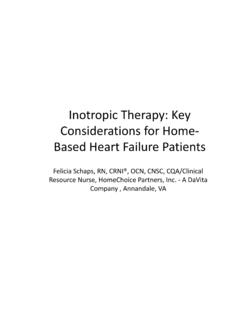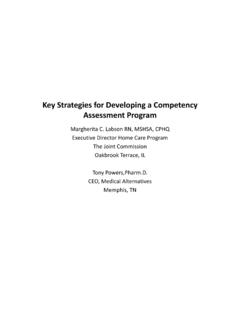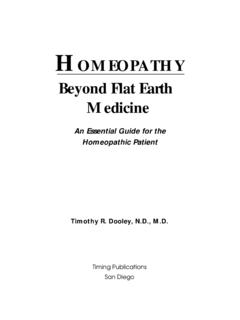Transcription of Medicare and Home Infusion - nhia.org
1 Medicare and Home InfusionAn NHIA White PaperProviding solutions for the home and specialty Infusion therapy community100 Daingerfield Road Alexandria, VA 22314703-549-3740 and Home InfusionAn NHIA White PaperiExecutive SummaryThe Medicare fee-for-service program stands virtually alone among payersin the United States in not fully recognizing the clinical and cost benefits ofproviding Infusion drug therapy to patients in their homes. Although Medicarecovers Infusion therapy in hospitals, skilled nursing facilities (SNFs), hospitaloutpatient departments (HOPDs), and physician offices, it does not ade-quately cover Infusion therapy furnished in patients homes. As a result, Medicare beneficiaries in need of Infusion therapy often must receive theirtreatments in health care facilities rather than in their homes, which is themost desirable, convenient, and by far the most cost-effective setting of care. This is unfortunate and unnecessary. For over 30 years, home Infusion ther-apy has been the standard of care and common practice in the private sec-tor.
2 Thus, patients covered by private health plans have access to homeinfusion therapy when the treatment is medically indicated and when re-quested by the patient s physician. Ironically, patients who have access tothis benefit under their private plans lose this coverage when they enroll inMedicare. Although Medicare pays for certain Infusion drugs provided in the home,most Medicare beneficiaries do not have access to home Infusion therapydue to gaps in coverage for the medically necessary services, supplies andequipment used to provide the therapy. Closing the gaps in coverage wouldalign the Medicare program with virtually all private payers, most MedicareAdvantage plans, Tricare and many state Medicaid Home Infusion Beneficiary Medicare s lack of reimbursement for Infusion therapy in the home settingcan lead to substantial beneficiary lifestyle disruptions, costs and potentialhealth care risks. Because Medicare covers Infusion services in institutionalsettings, the beneficiary either has to travel to a health care facility to receiveinfusion treatments, sometimes multiple times a day, or remain in the facilityfor the duration of the treatment episode.
3 The Avalere ReportUnder the assumptions described in the sidebar, there would be an esti-mated savings to the Medicare program for the 10-year period from 2015 to2024 of percent, or $80 million, of the overall cost of Infusion servicesthat migrate from HOPDs, physician offices, and SNFs to home. The first-year savings, assuming implementation in 2015, would be percent, or $ million. These calculations take into account the newMedicare Part B program expenditures that would result from new MedicarePart B coverage for Infusion -related services, supplies and equipment in thehome (the volume of all Medicare -covered anti-infective Infusion services in all settings, not just in the home would need to substantially rise by atleast percent for the expanded coverage to result in net increaseMedicare program expenditures). Avalere did not calculate the potential ad-ditional savings that could result from the avoidance of hospital stays andhospital-acquired Legislative SolutionCongress should enact the Medicare Home Infusion Site of Care Act, whichwould give physicians and Medicare beneficiaries the option to treat and re-ceive Infusion therapy in the most cost-effective setting.
4 The Avalere ReportWhy a Study Was Necessary For decades, the private sector has recognized that homeinfusion therapy is a cost-effective, clinically effective treat-ment option. Nonetheless, the Medicare fee-for-service pro-gram does not have a comprehensive home infusiontherapy benefit. Substantive changes to Medicare coveragepolicies will require credible evidence that similar savingsare possible in the provision of home Infusion therapy toMedicare beneficiaries. For that reason, NHIA commis-sioned Avalere Health to conduct a study of the potentialsavings to the Medicare program that could result fromMedicare coverage of Infusion therapy for anti-infectivedrugs in the home. Anti-infective Infusion therapy constitutesapproximately 50 percent of the treatments provided byhome Infusion providers. Thus, savings to the Medicare pro-gram from home Infusion of this therapy will likely drive thesavings that would result from providing a wider range oftherapies in patients NHIA Asked Avalere to Study NHIA asked Avalere to analyze the impact on Medicareprogram expenditures from a portion of patients receivinganti-infective Infusion therapy from skilled nursing facilities(SNFs), hospital outpatient departments (HOPDs), andphysicians offices shifting their Infusion treatment settingto the home.
5 The numbers of patients who were assumedto shift anti-infective Infusion settings to the home variedby their current setting, but averaged approximately 23percent of patients receiving anti-infective Infusion therapyin these settings. What Avalere Found Under these migration assumptions, there would be anestimated savings to the Medicare program for the 10-year period from 2015 to 2024 of percent, or $80million, of the overall cost of Infusion services that mi-grate from HOPDs, physician offices, and SNFs to first-year savings, assuming implementation in 2015,would be approximately percent, or $ calculations take into account the new MedicarePart B program expenditures that would result from newMedicare Part B coverage for Infusion -related services,supplies and equipment in the home (the volume of allMedicare-covered anti-infective Infusion services in allsettings, not just in the home would need to substan-tially rise by at least percent for the expanded cover-age to result in net increase Medicare programexpenditures).
6 Avalere did not calculate the potential ad-ditional savings that could result from the avoidance ofhospital stays and hospital-acquired the Full Report At and Home InfusionAn NHIA White PaperiiiTable of ContentsHome Infusion Services Under Medicare Would Provide Increased Clinical Quality for patients ..1 Current Medicare Coverage Policies ..3 Medicare Beneficiaries Suffer as a Result of the Lack of Access to Infusion Therapy Service in the Medicare Home Infusion Site of Care for the Congressional Budget Office ..6 Conclusion ..6 Appendix and Patient Stories ..7 Medicare and Home InfusionAn NHIA White Paper1 Home Infusion Services Under Medicare Would Enhance Quality of CareInfusion therapy involves the administration of medication through a needle or catheter. It is prescribed for patients whose conditionis so severe that they cannot be treated effectively by oral medications. Typically, Infusion therapy means that a drug is administeredintravenously, but the term also may refer to situations where drugs are provided through other non-oral routes, such as intramuscularinjections and epidural routes (into the membranes surrounding the spinal cord).
7 Diseases requiring Infusion therapy include infections that are unresponsive to oral antibiotics, cancer and cancer-related pain, de-hydration, and gastrointestinal diseases or disorders which prevent normal functioning of the gastrointestinal system. Other conditionstreated with specialty Infusion therapies may include cancers, congestive heart failure, Crohn s Disease, hemophilia, hepatitis, im-mune deficiencies, multiple sclerosis and rheumatoid Top Ten Most Frequent Diagnoses among patients Receiving Home InfusionNote: Diagnoses grouped by AHRQ Clinical Condition Software (CCS) categorySource: Sample of NHIA member company dataUntil the 1980s, patients receiving Infusion therapy had to remain in the inpatient setting for the duration of their therapy. Heightenedemphasis on cost-containment in health care, as well as developments in the clinical administration of the therapy has led to strate-gies to administer Infusion therapy in alternate settings. In addition to being cost-effective and clinically effective, patients often prefer to receive Infusion therapy in the comfort of theirhomes.
8 Importantly, patients treated at home instead of in a facility are at reduced risk of acquiring health care-acquired infections(HAI), which is a crucial safety consideration since many of these patients are at high risk of infection due to their age, compromisedimmune systems and, depending on their treatment, an opening in their body that is needed for the therapy. Infusion therapy originates with a prescription order from a physician or another qualified prescriber who is overseeing the care ofthe patient. The prescription order is sent to a home Infusion therapy provider, which is a state-licensed pharmacy that specializesin provision of Infusion 1020304050 Fluid/Electrolyte DiagnosesOther Bacterial InfectionsCHFC omplications of ProceduresPneumoniaSepticemiaColon CancerInfectious ArthritisOther Diagnoses of BladderSkin & Skin Structure and Home InfusionAn NHIA White Paper2A nationally-accepted, technical definition of a home Infusion therapy pharmacyis a:Pharmacy-based, decentralized patient care organization with expertise in USP <797> compliant sterile drug compoundingthat provides care to patients with acute or chronic conditions generally pertaining to parenteral administration of drugs, bi-ologics and nutritional formulae administered through catheters and/or needles in home and alternate sites.
9 Professionalpharmacy services, care coordination, Infusion nursing services, supplies and equipment are provided to optimize efficacyand specialized services, supplies, and equipment are necessary to ensure quality practices and outcomes for home infusionservices. The Infusion pharmacy ensures Infusion drugs are: Compounded in a sterile environment; Filled for individual prescriptions; Maintained in appropriate conditions to ensure sterility and stability; Administered at exactly the right dose and on the right schedule; Administered using the appropriate vascular access device (often a long-term device) which is placed in the correct anatomicallocation based on the expected duration of therapy, the pH, osmolarity, and osmolality of the medication, and that is maintainedusing the proper flushing solution between doses; Administered using an appropriate drug delivery device; Monitored for adverse reactions and therapeutic efficacy; and To ensure safe and proper administration of Infusion drugs, Infusion pharmacies provide the following services: Comprehensive assessment that considers patient history, current physical and mental status, lab reports, cognitive and psychoso-cial status, family/caregiver support, prescribed treatment, concurrent oral prescriptions, and over-the-counter medications.
10 Maintenance of appropriate procedures for the compounding and distribution of sterile Infusion products as outlined in the na-tional standards and state and federal regulations. Drug interaction monitoring and identification of potential drug, dose or drug-catheter incompatibilities. Comprehensive admission procedures that include patient education of medical equipment and supply use, medication storageand handling, emergency procedures, vascular access device management, proper storage and disposal of hazardous waste,as well as the recognition and reporting of adverse drug reactions. Comprehensive care planning that considers actual or potential drug or equipment-related problems, therapy monitoring withspecific patient goals, and coordination of activities with other providers such as home health agencies and physicians. Ongoing patient monitoring and reassessment activities to continually assess for response to treatment, drug complications,adverse reactions, and patient compliance.








